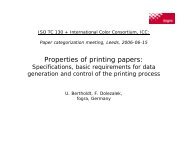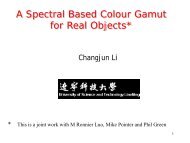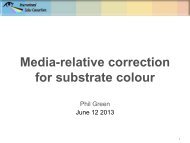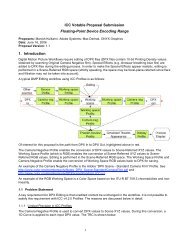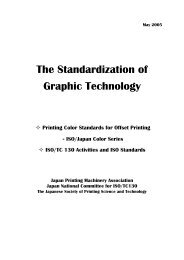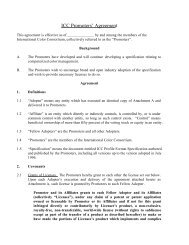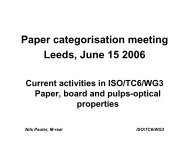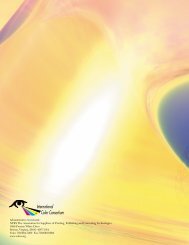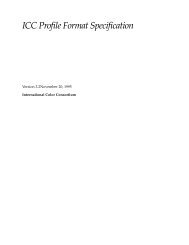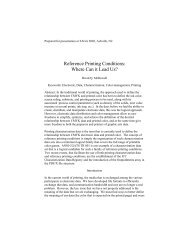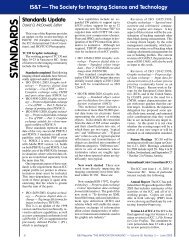ISO FDIS 15397 Communication of Graphic Paper Properties and ...
ISO FDIS 15397 Communication of Graphic Paper Properties and ...
ISO FDIS 15397 Communication of Graphic Paper Properties and ...
You also want an ePaper? Increase the reach of your titles
YUMPU automatically turns print PDFs into web optimized ePapers that Google loves.
<strong>ISO</strong> <strong>FDIS</strong> <strong>15397</strong> <strong>Communication</strong> <strong>of</strong> <strong>Graphic</strong> <strong>Paper</strong> <strong>Properties</strong> <strong>and</strong> Optics<br />
1 | © The <strong>Paper</strong>dam Group Luc LANAT <strong>Paper</strong>dam Leeds University Workshop<br />
Luc LAN<br />
2013 07 04
Messages in 1 slide<br />
§<br />
§<br />
§<br />
Close to be published <strong>ISO</strong> <strong>15397</strong> <strong>Communication</strong> <strong>of</strong> graphic paper<br />
properties adresses optic properties <strong>and</strong> requires:<br />
– To use paper equipement <strong>and</strong> metrics (D 65, d/0° spherical), for<br />
white paper color <strong>and</strong> visual perception evaluation.<br />
– To use printers equipment <strong>and</strong> metrics (D 50, 45°/0°) for printed<br />
paper color evaluation.<br />
In market industrial paper no value L* above 96. CIELAB max<br />
values (<strong>ISO</strong> 5631-2 D65/10°) are:<br />
– WF wood-free coated L* 95, b* -10.<br />
– UWF uncoated wood-free (copy paper) L* 94, b*-20.<br />
Issues with <strong>ISO</strong> 13655 conforming equipment.<br />
– L* reproducible, but a* <strong>and</strong> b* critical.<br />
– Fluorescence evaluation must be improved thru calibration<br />
routines.<br />
2 | © The <strong>Paper</strong>dam Group Luc LANAT <strong>Paper</strong>dam Leeds University Workshop 2013 07 04
Supporting slides<br />
3 | © The <strong>Paper</strong>dam Group Luc LANAT <strong>Paper</strong>dam Leeds University Workshop<br />
2013 07 04
TC 130/WG4 N762<br />
© <strong>ISO</strong> 2013 – All rights reserved<br />
<strong>ISO</strong>/TC 130/N xxxx<br />
Date: 2013-06-25<br />
<strong>ISO</strong>/<strong>FDIS</strong> <strong>15397</strong>:2013(E)<br />
<strong>ISO</strong>/TC 130/SC /WG 4 N xxxx<br />
Secretariat:<br />
DIN<br />
<strong>Graphic</strong> Technology — <strong>Communication</strong> <strong>of</strong> graphic paper properties<br />
Technologie graphique — <strong>Communication</strong> des propriétés des papiers graphiques<br />
4 | © The <strong>Paper</strong>dam Group Luc LANAT <strong>Paper</strong>dam Leeds University Workshop<br />
2013 07 04
Contents<br />
Page<br />
Foreword ......................................................................................................................................................iv<br />
Introduction...................................................................................................................................................v<br />
1 Scope................................................................................................................................................1<br />
2 Normative references.......................................................................................................................1<br />
3 Terms <strong>and</strong> definitions ......................................................................................................................2<br />
4 List <strong>of</strong> required criteria for communication <strong>of</strong> paper properties....................................................5<br />
5 <strong>ISO</strong> st<strong>and</strong>ards related to required criteria.......................................................................................7<br />
5.1 General information useful for technical communication ..............................................................7<br />
5.2 Br<strong>and</strong> name <strong>and</strong> paper mill..............................................................................................................7<br />
5.2.1 Br<strong>and</strong> name ......................................................................................................................................7<br />
5.2.2 <strong>Paper</strong> mill..........................................................................................................................................7<br />
5.3 Grammage ........................................................................................................................................7<br />
5.4 Bulk <strong>and</strong>/or Thickness .....................................................................................................................7<br />
5.5 Roughness for evaluation <strong>of</strong> surface properties ............................................................................7<br />
5.5.1 General..............................................................................................................................................7<br />
5.5.2 Roughness ("PPS")..........................................................................................................................8<br />
5.5.3 Roughness ("Bendtsen") .................................................................................................................8<br />
5.5.4 Smoothness ("Bekk").......................................................................................................................8<br />
5.6 Gloss.................................................................................................................................................8<br />
5.7 Opacity..............................................................................................................................................8<br />
5.8 Brightness <strong>and</strong> Whiteness <strong>of</strong> unprinted paper ...............................................................................9<br />
5.8.1 General..............................................................................................................................................9<br />
5.8.2 <strong>ISO</strong> Brightness <strong>and</strong> D65 Brightness................................................................................................9<br />
5.8.3 Whiteness C/2° .................................................................................................................................9<br />
5.8.4 Whiteness D65/10°............................................................................................................................9<br />
5.9 Colour measurement <strong>of</strong> paper white point in printing conditions (D50/2°) .................................10<br />
5.10 Colour measurement <strong>of</strong> unprinted paper in outdoor conditions (D65/10°)..................................10<br />
5.11 Supported colour gamut in the context <strong>of</strong> prepress design.........................................................10<br />
5.12 Fluorescence in the context <strong>of</strong> prepress.......................................................................................10<br />
5.13 Storage conditions, influence <strong>of</strong> aging <strong>and</strong> testing conditions for pro<strong>of</strong>ing substrates ............11<br />
5.14 Bending resistance (bending stiffness) for Sheet-Fed Offset printing substrates......................11<br />
Bibliography................................................................................................................................................12<br />
5 | © The <strong>Paper</strong>dam Group Luc LANAT <strong>Paper</strong>dam Leeds University Workshop<br />
2013 07 04
Introduction 1/2<br />
<strong>ISO</strong>/DIS <strong>15397</strong><br />
78<br />
79<br />
80<br />
81<br />
82<br />
83<br />
84<br />
85<br />
86<br />
87<br />
88<br />
89<br />
90<br />
91<br />
92<br />
93<br />
94<br />
95<br />
96<br />
Introduction<br />
This document is intended to improve communication between the graphic papermaking industry <strong>and</strong> the<br />
printing industry based on their need to be able to produce quality printing. <strong>Paper</strong> properties <strong>and</strong> their<br />
measurement are presented <strong>and</strong> their use in the printing context is described.<br />
This st<strong>and</strong>ard describes data to be provided for reliable printing. One may assess a substrate description to<br />
be in conformance with this st<strong>and</strong>ard, not a substrate itself.<br />
Printing press settings depend on paper grade, <strong>and</strong> several paper properties are required in order to define a<br />
grade.<br />
<strong>Paper</strong> measurement st<strong>and</strong>ards developed within <strong>ISO</strong> TC 6 are referenced in this International St<strong>and</strong>ard. They<br />
were mainly used to develop paper industry test methods <strong>and</strong> allow the papermaking processes to be<br />
reproducible <strong>and</strong> reliable within the paper mills. It is recommended that paper purchasing specifications be<br />
based on paper industry st<strong>and</strong>ards. This recommendation also applies to paper pro<strong>of</strong>ing substrates. Special<br />
requirements for paper substrates for the reliable production <strong>of</strong> printed products need to be communicated on<br />
the basis <strong>of</strong> st<strong>and</strong>ards developed by TC 6 whenever possible.<br />
The evaluation <strong>of</strong> colour <strong>of</strong> the unprinted paper is critical to define prepress white point settings This<br />
measurement can be performed with either diffuse:0° integrating sphere instruments (papermaker´s<br />
equipment) or 45°:0° instruments (printers equipment). Results are <strong>of</strong>ten close if the UV calibration is<br />
performed correctly. This International St<strong>and</strong>ard specifies 45°:0° instruments (printers equipment) to perform<br />
this evaluation as per <strong>ISO</strong> 13655, because obviously widely available at printers facilities.<br />
6 | © The <strong>Paper</strong>dam Group Luc LANAT <strong>Paper</strong>dam Leeds University Workshop<br />
2013 07 04
84<br />
85<br />
86<br />
87<br />
88<br />
89<br />
90<br />
91<br />
92<br />
93<br />
94<br />
95<br />
96<br />
97<br />
98<br />
99<br />
100<br />
101<br />
102<br />
103<br />
104<br />
105<br />
106<br />
107<br />
Printing press settings depend on paper grade, <strong>and</strong> several paper properties are required in order to define a<br />
grade.<br />
<strong>Paper</strong> measurement st<strong>and</strong>ards developed within <strong>ISO</strong> TC 6 are referenced in this International St<strong>and</strong>ard. They<br />
were mainly used to develop paper industry test methods <strong>and</strong> allow the papermaking processes to be<br />
reproducible <strong>and</strong> reliable within the paper mills. It is recommended that paper purchasing specifications be<br />
based on paper industry st<strong>and</strong>ards. This recommendation also applies to paper pro<strong>of</strong>ing substrates. Special<br />
requirements for paper substrates for the reliable production <strong>of</strong> printed products need to be communicated on<br />
the basis <strong>of</strong> st<strong>and</strong>ards developed by TC 6 whenever possible.<br />
Introduction 2/2<br />
The evaluation <strong>of</strong> colour <strong>of</strong> the unprinted paper is critical to define prepress white point settings This<br />
measurement can be performed with either diffuse:0° integrating sphere instruments (papermaker´s<br />
equipment) or 45°:0° instruments (printers equipment). Results are <strong>of</strong>ten close if the UV calibration is<br />
performed correctly. This International St<strong>and</strong>ard specifies 45°:0° instruments (printers equipment) to perform<br />
this evaluation as per <strong>ISO</strong> 13655, because obviously widely available at printers facilities.<br />
For the evaluation <strong>of</strong> printed colours, measurement devices are developed according to <strong>ISO</strong> 13655 which<br />
differ from the colour measurement devices in conformance to <strong>ISO</strong> 2469 <strong>and</strong> <strong>ISO</strong> 5631 1-2-3. The latter type<br />
<strong>of</strong> instruments is used within paper mills for quality evaluation during paper manufacturing <strong>and</strong> unprinted<br />
paper colour evaluation.!<br />
<strong>Properties</strong> linked to the printing process (examples: dimensions, blistering <strong>and</strong> picking resistance in <strong>of</strong>fset,<br />
missing dots in gravure) are not described in this st<strong>and</strong>ard, since they are implicitly needed when purchasing<br />
the paper meant for this printing process.<br />
<strong>Properties</strong> that are not based on <strong>ISO</strong> st<strong>and</strong>ards are not described here.<br />
The bibliography lists basic references in <strong>Graphic</strong> technology st<strong>and</strong>ards [1] [2], <strong>Paper</strong> <strong>and</strong> board st<strong>and</strong>ards [3],<br />
previously published references [4], commercial classifications [5], conditions <strong>of</strong> Sale [6], <strong>and</strong> reference lists <strong>of</strong><br />
printing characterisation data publicly available [8].<br />
7 | © The <strong>Paper</strong>dam Group Luc LANAT <strong>Paper</strong>dam Leeds University Workshop<br />
2013 07 04
DRAFT INTERNATIONAL STANDARD <strong>ISO</strong>/DIS <strong>15397</strong><br />
<strong>ISO</strong> <strong>FDIS</strong> <strong>15397</strong> Scope<br />
108<br />
109<br />
<strong>Graphic</strong> Technology — <strong>Communication</strong> <strong>of</strong> graphic paper<br />
properties<br />
110<br />
111<br />
112<br />
113<br />
114<br />
115<br />
116<br />
117<br />
118<br />
119<br />
120<br />
121<br />
1 Scope<br />
This International St<strong>and</strong>ard specifies the list <strong>of</strong> paper substrate relevant properties to be communicated<br />
between the paper <strong>and</strong> the printing industries.<br />
This International St<strong>and</strong>ard is applicable to papers intended to be printed in rotogravure, cold-set web <strong>of</strong>fset,<br />
heat-set web <strong>of</strong>fset, sheet-fed <strong>of</strong>fset, <strong>and</strong> flexographic printing processes <strong>and</strong> to pro<strong>of</strong>ing substrates.<br />
Where multiple measures exist the preferred procedure <strong>and</strong> its International St<strong>and</strong>ard is defined.<br />
All measuring methods <strong>of</strong> properties specified in this International St<strong>and</strong>ard are described in <strong>ISO</strong> St<strong>and</strong>ards.<br />
2 Normative references<br />
The following referenced documents are indispensable for the application <strong>of</strong> this document. For dated<br />
references, only the edition cited applies. For undated references, the latest edition <strong>of</strong> the referenced<br />
document (including any amendments) applies.<br />
<strong>ISO</strong> 186, <strong>Paper</strong> <strong>and</strong> board — Sampling to determine average quality<br />
122 <strong>ISO</strong> 187, <strong>Paper</strong>, board <strong>and</strong> pulps — St<strong>and</strong>ard atmosphere for conditioning <strong>and</strong> testing <strong>and</strong> procedure for<br />
123 monitoring the atmosphere <strong>and</strong> conditioning <strong>of</strong> samples<br />
8 | © The <strong>Paper</strong>dam Group Luc LANAT <strong>Paper</strong>dam Leeds University Workshop<br />
2013 07 04<br />
124 <strong>ISO</strong> 534, <strong>Paper</strong> <strong>and</strong> board — Determination <strong>of</strong> thickness, density <strong>and</strong> specific volume
299<br />
force required to bend a rectangular test piece clamped at one end<br />
300<br />
301<br />
302<br />
303<br />
304<br />
305<br />
306<br />
307<br />
[SOURCE: <strong>ISO</strong> 2493-1:2010, Clause 3.1-3.2]<br />
NOTE 1 to entry: bending stiffness is the resistance that a test piece <strong>of</strong>fers to bend, in the region <strong>of</strong> elastic deformation<br />
[SOURCE: <strong>ISO</strong> 5628:2012, Clause 3.1]<br />
4 List <strong>of</strong> required criteria for communication <strong>of</strong> paper properties<br />
For rotogravure, cold-set <strong>of</strong>fset, heat-set web <strong>of</strong>fset, sheet-fed <strong>of</strong>fset, flexographic <strong>and</strong> pro<strong>of</strong>ing printing<br />
substrates, the intended use or printing process shall be identified <strong>and</strong> the following data shall be<br />
communicated by the paper manufacturer, with target values.<br />
<strong>ISO</strong>/DIS <strong>15397</strong><br />
a) br<strong>and</strong> name <strong>and</strong> optionally paper mill (as per Clause 5.2)<br />
308<br />
309<br />
310<br />
311<br />
312<br />
313<br />
314<br />
315<br />
316<br />
317<br />
318<br />
319<br />
320<br />
b) grammage (as per Clause 5.3)<br />
© <strong>ISO</strong> 2012 – All rights reserved 5<br />
c) bulk <strong>and</strong>/or thickness (as per Clause 5.4)<br />
d) roughness PPS (Parker-Print Surf) or roughness Bendtsen or smoothness Bekk (as per Clause 5.5)<br />
For Rotogravure substrates, only roughness PPS is meaningful, values being usually below 3. When<br />
roughness PPS values are above 3, the use <strong>of</strong> roughness Bendtsen is recommended. When roughness<br />
Bendtsen is below 100, smoothness Bekk may be used, in particular in smooth writing papers.<br />
e) gloss value <strong>and</strong> for pro<strong>of</strong>ing substrates characterization according to <strong>ISO</strong> 12647-7 (“glossy”, “semi-matte”<br />
or “matte”) (as per Clause 5.6)<br />
The gloss level <strong>and</strong> the equipment used will determine the International St<strong>and</strong>ard to be used. The<br />
International St<strong>and</strong>ard shall therefore be cited when communicating gloss values.<br />
NOTE 1 <strong>ISO</strong> 12647-7 characterizes pro<strong>of</strong>ing substrates measured according to <strong>ISO</strong> 8254-1 as “glossy” for values<br />
larger or equal to 60, as “matte” for values smaller or equal to 20 <strong>and</strong> “semi matte” in between.<br />
f) opacity (as per Clause 5.7)<br />
321 g) brightness <strong>and</strong>/or whiteness for visual appearance evaluation <strong>of</strong> unprinted paper (as per Clause 5.8)<br />
9 | © The <strong>Paper</strong>dam Group Luc LANAT <strong>Paper</strong>dam Leeds University Workshop<br />
2013 07 04
315<br />
or “matte”) (as per Clause 5.6)<br />
316<br />
317<br />
318<br />
319<br />
320<br />
321<br />
322<br />
323<br />
324<br />
325<br />
326<br />
327<br />
328<br />
329<br />
330<br />
331<br />
332<br />
333<br />
334<br />
335<br />
336<br />
The gloss level <strong>and</strong> the equipment used will determine the International St<strong>and</strong>ard to be used. The<br />
International St<strong>and</strong>ard shall therefore be cited when communicating gloss values.<br />
NOTE 1 <strong>ISO</strong> 12647-7 characterizes pro<strong>of</strong>ing substrates measured according to <strong>ISO</strong> 8254-1 as “glossy” for values<br />
larger or equal to 60, as “matte” for values smaller or equal to 20 <strong>and</strong> “semi matte” in between.<br />
f) opacity (as per Clause 5.7)<br />
g) brightness <strong>and</strong>/or whiteness for visual appearance evaluation <strong>of</strong> unprinted paper (as per Clause 5.8)<br />
Whiteness is recommended, but Brightness will bring useful information. This choice will determine the<br />
International St<strong>and</strong>ard to be used. The International St<strong>and</strong>ard used shall therefore be cited when<br />
communicating Whiteness <strong>and</strong> Brightness values.<br />
NOTE 2 Brightness <strong>and</strong> Whiteness st<strong>and</strong>ards are available either for C illuminant or D65 illuminant. The choice <strong>of</strong> the<br />
illuminant depends <strong>of</strong> the end-user viewing conditions.<br />
h) colour coordinates L*, a*, b* with D50 illuminant <strong>and</strong> CIE 1931 St<strong>and</strong>ard Colorimetric Observer [9] for<br />
paper white point in printing conditions (as per Clause 5.9)<br />
i) colour coordinates L*, a*, b* with D65 illuminant <strong>and</strong> CIE 1964 St<strong>and</strong>ard Colorimetric Observer for<br />
unprinted paper in outdoor conditions (as per Clause 5.10)<br />
j) supported colour gamut in the context <strong>of</strong> prepress design (as per Clause 5.11)<br />
k) fluorescence or fluorescence estimate in the context <strong>of</strong> prepress. (as per Clause 5.12)<br />
NOTE 3 To avoid distortions due to Fluorescence <strong>and</strong> for the purpose <strong>of</strong> pro<strong>of</strong> to print match, pro<strong>of</strong>ing substrates <strong>and</strong><br />
production papers need to be visually evaluated <strong>and</strong> measured each with the same amount <strong>of</strong> UV-content <strong>of</strong> the D50<br />
simulator according to both <strong>ISO</strong> 13655 <strong>and</strong> <strong>ISO</strong> 3664.<br />
For pro<strong>of</strong>ing substrates, the following additional properties shall be communicated.<br />
337 l) storage conditions (as per Clause 5.13)<br />
338<br />
10 | © The <strong>Paper</strong>dam Group Luc LANAT <strong>Paper</strong>dam Leeds University Workshop<br />
2013 07 04<br />
Recommended storage conditions shall be specified due to the importance <strong>of</strong> pro<strong>of</strong>ing substrates to colour
326<br />
illuminant depends <strong>of</strong> the end-user viewing conditions.<br />
327<br />
328<br />
329<br />
330<br />
331<br />
332<br />
333<br />
334<br />
335<br />
336<br />
337<br />
338<br />
339<br />
340<br />
341<br />
h) colour coordinates L*, a*, b* with D50 illuminant <strong>and</strong> CIE 1931 St<strong>and</strong>ard Colorimetric Observer [9] for<br />
paper white point in printing conditions (as per Clause 5.9)<br />
i) colour coordinates L*, a*, b* with D65 illuminant <strong>and</strong> CIE 1964 St<strong>and</strong>ard Colorimetric Observer for<br />
unprinted paper in outdoor conditions (as per Clause 5.10)<br />
j) supported colour gamut in the context <strong>of</strong> prepress design (as per Clause 5.11)<br />
k) fluorescence or fluorescence estimate in the context <strong>of</strong> prepress. (as per Clause 5.12)<br />
NOTE 3 To avoid distortions due to Fluorescence <strong>and</strong> for the purpose <strong>of</strong> pro<strong>of</strong> to print match, pro<strong>of</strong>ing substrates <strong>and</strong><br />
production papers need to be visually evaluated <strong>and</strong> measured each with the same amount <strong>of</strong> UV-content <strong>of</strong> the D50<br />
simulator according to both <strong>ISO</strong> 13655 <strong>and</strong> <strong>ISO</strong> 3664.<br />
For pro<strong>of</strong>ing substrates, the following additional properties shall be communicated.<br />
l) storage conditions (as per Clause 5.13)<br />
Recommended storage conditions shall be specified due to the importance <strong>of</strong> pro<strong>of</strong>ing substrates to colour<br />
management.<br />
For sheet-fed <strong>of</strong>fset printing substrates, the following additional properties should be communicated.<br />
m) bending resistance (bending stiffness) (as per Clause 5.14)<br />
© <strong>ISO</strong> 2012 – All rights reserved 6<br />
11 | © The <strong>Paper</strong>dam Group<br />
Luc LANAT <strong>Paper</strong>dam<br />
2013 07 02
<strong>ISO</strong>/DIS <strong>15397</strong><br />
449<br />
450<br />
451<br />
452<br />
453<br />
454<br />
455<br />
456<br />
457<br />
458<br />
459<br />
460<br />
461<br />
462<br />
463<br />
464<br />
465<br />
466<br />
467<br />
468<br />
NOTE CIE Whiteness D65/10° is typically used in Medium Weight Coated (MWC), Wood-Free Coated (WFC),<br />
Uncoated Wood Free (UWF) grades, <strong>of</strong>ten in European markets.<br />
5.9 Colour measurement <strong>of</strong> paper white point in printing conditions (D50/2°)<br />
Refers to Clause 4 h)<br />
CIELAB values <strong>of</strong> paper shall be communicated in accordance with specific measurement conditions<br />
<strong>of</strong> <strong>ISO</strong> 13655. <strong>ISO</strong> 13655 recommends that all measurements should be made with M1 measuring conditions.<br />
These data depend also on the measurement device used. The measurement condition, the backing, the type<br />
<strong>and</strong> the manufacturer <strong>of</strong> the device, shall be communicated together with the CIELAB data, as required by<br />
<strong>ISO</strong> 13655.<br />
When M1 condition <strong>of</strong> <strong>ISO</strong> 13655 is not available, the M0 condition may be used for communication <strong>and</strong><br />
relative evaluation.<br />
NOTE 1 CIELAB values for colour measurement <strong>of</strong> paper white point in printing conditions (D50/2°) are needed for<br />
graphic art prepress <strong>and</strong> colour management applications.<br />
NOTE 2 Measurements <strong>of</strong> papers containing fluorescent additives, such as OBA, using instruments with M0 or M2<br />
source conditions will not result in readings that are consistent with those obtained using M1 source conditions.<br />
NOTE 3 <strong>ISO</strong> 13655 (for measurement) <strong>and</strong> <strong>ISO</strong> 3664 (for viewing) provide precise recommendations <strong>of</strong> the spectral<br />
power <strong>and</strong> UV content <strong>of</strong> illumination to be used in the printing chain to ensure consistent <strong>and</strong> predictable values.<br />
5.10 Colour measurement <strong>of</strong> unprinted paper in outdoor conditions (D65/10°)<br />
Refers to Clause 4 i)<br />
<strong>Paper</strong> Colour shall be communicated on the basis <strong>of</strong> measurements made in accordance with <strong>ISO</strong> 5631-2.<br />
12 | © The <strong>Paper</strong>dam Group Luc LANAT <strong>Paper</strong>dam Leeds University Workshop<br />
2013 07 04
256<br />
whiteness units<br />
257<br />
258<br />
259<br />
260<br />
261<br />
262<br />
263<br />
264<br />
265<br />
266<br />
267<br />
NOTE 1 to entry: Whiteness measures the paper’s ability to reflect light across wavelengths comprising the full spectrum.<br />
It gives single figure information, including both brightness <strong>and</strong> shade <strong>and</strong> is therefore increasingly replacing brightness as<br />
first criterion <strong>of</strong> quality.<br />
NOTE 2 to entry: The CIE whiteness equation defines a line along the dominant wavelength 425nm in the CIE<br />
chromaticity diagram along which the whiteness increases the most. This equation has thus a preference towards red. It is<br />
important to note that the equation is only valid within a relative narrow interval <strong>of</strong> the colour space.<br />
[SOURCE: <strong>ISO</strong> 11475:2004, Clause 3.4]<br />
3.16<br />
fluorescence component<br />
<strong>ISO</strong>/DIS <strong>15397</strong><br />
measure <strong>of</strong> the extent to which the whiteness <strong>of</strong> the material is affected by excitation <strong>of</strong> the added fluorescent<br />
whitening agent (FWA) or optical brightening agent (OBA)<br />
268<br />
269<br />
270<br />
271<br />
272<br />
273<br />
274<br />
275<br />
276<br />
277<br />
278<br />
279<br />
280<br />
281<br />
282<br />
[SOURCE: <strong>ISO</strong> 11476:2010, Clause 3.7]<br />
© <strong>ISO</strong> 2012 – All rights reserved 4<br />
NOTE 1 to entry: Fluorescent whitening agents (FWA) are also called optical brightening agents (OBA)<br />
NOTE 2 to entry: Fluorescence component is calculated as the difference between the whiteness/brightness measured<br />
with a source <strong>of</strong> light having a UV-content corresponding to the chosen illuminant <strong>and</strong> the whiteness/brightness measured<br />
with a source without radiation <strong>of</strong> the excitation b<strong>and</strong>.<br />
NOTE 3 to entry: Fluorescence component measured with Brightness <strong>and</strong> D65 illuminant is most widely used with<br />
notation F B, D65<br />
[SOURCE: <strong>ISO</strong> TR 10688 Clause 4.10]<br />
3.17<br />
CIELAB colour space <strong>and</strong> CIELAB values<br />
three-dimensional, approximately uniform colour space, produced by plotting, in rectangular coordinates L*,<br />
a*, b*<br />
NOTE 1 to entry: The quantity L* is a measure <strong>of</strong> the lightness, where L* = 0 corresponds to black <strong>and</strong> L* = 100<br />
corresponds to the perfect reflecting diffuser. Visually, the quantities a* <strong>and</strong> b* represent respectively the red-green <strong>and</strong><br />
yellow-blue axes in colour space, such that:+a* is a measure <strong>of</strong> the degree <strong>of</strong> redness;<br />
13 | 283 © The <strong>Paper</strong>dam −a* is a measure Group <strong>of</strong> the Luc degree LANAT <strong>of</strong> <strong>Paper</strong>dam greenness; Leeds University Workshop<br />
2013 07 04
279<br />
a*, b*<br />
280<br />
281<br />
282<br />
283<br />
284<br />
285<br />
286<br />
287<br />
288<br />
289<br />
290<br />
291<br />
292<br />
293<br />
294<br />
295<br />
296<br />
297<br />
298<br />
299<br />
300<br />
301<br />
302<br />
NOTE 1 to entry: The quantity L* is a measure <strong>of</strong> the lightness, where L* = 0 corresponds to black <strong>and</strong> L* = 100<br />
corresponds to the perfect reflecting diffuser. Visually, the quantities a* <strong>and</strong> b* represent respectively the red-green <strong>and</strong><br />
yellow-blue axes in colour space, such that:+a* is a measure <strong>of</strong> the degree <strong>of</strong> redness;<br />
−a* is a measure <strong>of</strong> the degree <strong>of</strong> greenness;<br />
+b* is a measure <strong>of</strong> the degree <strong>of</strong> yellowness;<br />
−b* is a measure <strong>of</strong> the degree <strong>of</strong> blueness.<br />
If both a* <strong>and</strong> b* are equal to zero, the test piece is grey.<br />
[SOURCE: <strong>ISO</strong> 5631-2:2008, Clause 3.6]<br />
3.18<br />
M0, M1, M2 measurement conditions<br />
Measurement condition M0 requires the source illumination to closely match that <strong>of</strong> illuminant A; this provides<br />
consistency with existing instrumentation <strong>and</strong> <strong>ISO</strong> 5-3. Measurement condition M1 requires the colorimetry <strong>of</strong><br />
the specimen illumination to closely match CIE illuminant D50. Measurement condition M2 only requires that<br />
the spectral power distribution <strong>of</strong> the specimen illumination be provided in the wavelength range from 420 nm<br />
to at least 700 nm <strong>and</strong> have no substantial radiation power in the wavelength range below 400nm (<strong>of</strong>ten<br />
referred to as “UVCut”)<br />
[SOURCE: <strong>ISO</strong> 13655-2009 Introduction]<br />
3.19<br />
bending resistance<br />
force required to bend a rectangular test piece clamped at one end<br />
[SOURCE: <strong>ISO</strong> 2493-1:2010, Clause 3.1-3.2]<br />
NOTE 1 to entry: bending stiffness is the resistance that a test piece <strong>of</strong>fers to bend, in the region <strong>of</strong> elastic deformation<br />
[SOURCE: <strong>ISO</strong> 5628:2012, Clause 3.1]<br />
14 | © The <strong>Paper</strong>dam Group Luc LANAT <strong>Paper</strong>dam Leeds University Workshop<br />
2013 07 04<br />
303<br />
4 List <strong>of</strong> required criteria for communication <strong>of</strong> paper properties
475<br />
476<br />
477<br />
478<br />
479<br />
480<br />
481<br />
482<br />
483<br />
484<br />
485<br />
486<br />
487<br />
488<br />
Printing characterization data recommendations, based on publicly available alternatives shall be<br />
communicated. A list <strong>of</strong> publicly available alternatives is given in [8].<br />
Where substrates characteristics are included with the characterization data, they should be defined in the<br />
terms defined in this st<strong>and</strong>ard.<br />
If no “well recognised” characterization data is available or has not yet been developed, this shall be stated<br />
<strong>and</strong> information should be provided.<br />
5.12 Fluorescence in the context <strong>of</strong> prepress<br />
Refers to Clause 4 k)<br />
To improve the visual perceived brightness/whiteness <strong>of</strong> substrates optical brighteners (OBA) (also called<br />
fluorescent whitening agents (FWA)) are commonly used. These substances absorb ultraviolet light <strong>and</strong> emit<br />
blue light. For unprinted substrates therefore the "reflection" within the blue region <strong>of</strong>ten exceeds 100 %. It<br />
shall be recognized that a single measurement condition does not characterize this situation <strong>ISO</strong>/DIS sufficiently. <strong>15397</strong> The<br />
lack <strong>of</strong> a more comprehensive model nonetheless forces the users to apply the CIELAB model also for<br />
fluorescent samples. Fluorescence results in a significant decrease <strong>of</strong> the b*-coordinate <strong>of</strong> the CIELAB<br />
489<br />
490<br />
491<br />
492<br />
493<br />
494<br />
495<br />
496<br />
measurement data if UV light is present, compared to measurements made in its absence. Brightness <strong>and</strong><br />
Whiteness show significantly larger values with increased excitation <strong>of</strong> the OBA.<br />
© <strong>ISO</strong> 2012 – All rights reserved 10<br />
Fluorescence is communicated in the context <strong>of</strong> Colour Management adjustments.<br />
The following method shall be used to measure Fluorescence: calculate the difference <strong>of</strong> D65 Brightness<br />
measurement performed with UV <strong>and</strong> with a UV-cut-<strong>of</strong>f filter (<strong>of</strong>ten referred as the difference UV-UVX),<br />
according to clause 8.4 <strong>of</strong> <strong>ISO</strong> 2470-2 <strong>Paper</strong>, board <strong>and</strong> pulps — Measurement <strong>of</strong> diffuse blue reflectance<br />
factor — Part 2: Outdoor daylight conditions (D65 brightness). This st<strong>and</strong>ard refers to illuminant D65/10°<br />
conditions <strong>and</strong> diffuse:0° equipment.<br />
497<br />
NOTE 1<br />
Other, non-preferred alternatives <strong>and</strong> working routines are used within paper mills to evaluate Fluorescence<br />
498<br />
499<br />
Alternatively, a classification in 4 levels: faint, low, moderate, high, is a relevant estimate <strong>of</strong> fluorescence<br />
components. Usual limits for Fluorescence : faint (>0), low (>4), moderate (>8), high (>14).<br />
500 15 | © The Reflectance <strong>Paper</strong>dam evaluated Group as Luc per LANAT <strong>ISO</strong> <strong>Paper</strong>dam 13655 M1 Leeds <strong>and</strong> University M2 measuring Workshop conditions <strong>and</strong> in particular the difference 2013 07 <strong>of</strong> 04<br />
501 the CIE-b*-values indicates the degree <strong>of</strong> fluorescence that can be expected in graphic arts viewing <strong>and</strong>
489<br />
490<br />
491<br />
492<br />
493<br />
494<br />
495<br />
496<br />
measurement data if UV light is present, compared to measurements made in its absence. Brightness <strong>and</strong><br />
Whiteness show significantly larger values with increased excitation <strong>of</strong> the OBA.<br />
Fluorescence is communicated in the context <strong>of</strong> Colour Management adjustments.<br />
The following method shall be used to measure Fluorescence: calculate the difference <strong>of</strong> D65 Brightness<br />
measurement performed with UV <strong>and</strong> with a UV-cut-<strong>of</strong>f filter (<strong>of</strong>ten referred as the difference UV-UVX),<br />
according to clause 8.4 <strong>of</strong> <strong>ISO</strong> 2470-2 <strong>Paper</strong>, board <strong>and</strong> pulps — Measurement <strong>of</strong> diffuse blue reflectance<br />
factor — Part 2: Outdoor daylight conditions (D65 brightness). This st<strong>and</strong>ard refers to illuminant D65/10°<br />
conditions <strong>and</strong> diffuse:0° equipment.<br />
497<br />
NOTE 1<br />
Other, non-preferred alternatives <strong>and</strong> working routines are used within paper mills to evaluate Fluorescence<br />
498<br />
499<br />
500<br />
501<br />
502<br />
503<br />
504<br />
505<br />
506<br />
507<br />
508<br />
509<br />
510<br />
511<br />
512<br />
Alternatively, a classification in 4 levels: faint, low, moderate, high, is a relevant estimate <strong>of</strong> fluorescence<br />
components. Usual limits for Fluorescence : faint (>0), low (>4), moderate (>8), high (>14).<br />
Reflectance evaluated as per <strong>ISO</strong> 13655 M1 <strong>and</strong> M2 measuring conditions <strong>and</strong> in particular the difference <strong>of</strong><br />
the CIE-b*-values indicates the degree <strong>of</strong> fluorescence that can be expected in graphic arts viewing <strong>and</strong><br />
measurements.<br />
NOTE 2 Optical Brightening Agents (OBA) are used in papermaking to achieve a high visual brightness or whiteness.<br />
The use <strong>of</strong> OBA influences paper colour properties under UV light <strong>and</strong> UV-containing illumination such as daylight<br />
simulating illumination sources. This excited emission influences the properties <strong>of</strong> white paper.<br />
NOTE 3 Fluorescent radiance depends not only on the UV content <strong>of</strong> the light, but also on the measurement<br />
equipment used. UV calibration <strong>and</strong> the colour rendering quality <strong>of</strong> light sources to simulate the reference illuminant are<br />
critical issues. Geometry (diffuse:0°, 45°:0°, 0°:45°) is less critical in this respect, see recent studies [7]! <strong>and</strong> the fact that<br />
luminescence is a totally Lambertian emission <strong>and</strong> hence will be nearly independent <strong>of</strong> the influx <strong>and</strong> efflux geometry.<br />
NOTE 4 Deviations occur where fluorescence is present <strong>and</strong> when the UV content <strong>of</strong> measurement <strong>and</strong> viewing light<br />
source are different. <strong>ISO</strong> 3664 describes st<strong>and</strong>ardized conditions for the viewing <strong>of</strong> pro<strong>of</strong>s <strong>and</strong> prints.<br />
5.13 Storage conditions, influence <strong>of</strong> aging <strong>and</strong> testing conditions for pro<strong>of</strong>ing substrates<br />
513 Refers to Clause 4 l)<br />
514<br />
16 | © The <strong>Paper</strong>dam Group Luc LANAT <strong>Paper</strong>dam Leeds University Workshop<br />
2013 07 04<br />
To evaluate the influence <strong>of</strong> storage conditions <strong>and</strong> communicate the influence <strong>of</strong> aging, CIELAB values <strong>of</strong>
<strong>Paper</strong>dam Foundation contributors<br />
2013<br />
Contributors from 7 paper companies:<br />
1. Hans-J. DRENK Norske Skog<br />
2. Jouni MARTTILA SAPPI<br />
3. Jozie DAHLMANS SAPPI<br />
4. Peter PETERMANN Stora Enso<br />
5. Carsten BOCKMANN UPM<br />
6. Thomas HERBST Leipa<br />
7. Joan FONT Lecta<br />
8. Jan ANDERSSON Holmen<br />
Stakeholders <strong>and</strong> Honorary :<br />
1. Wilco de GROOT IGT, Convenor TC6-TC 130 JWG 39<br />
2. Luc LANAT Convenor <strong>and</strong> Chairman <strong>of</strong> <strong>Paper</strong>dam Foundation, past ATIP President<br />
Follow our work :<br />
§ Daniel HAWKRIGG Iggesund (Holmen)<br />
§ Frank WERTHSCHULTE Stora Enso<br />
§ Gerd CARL UPM<br />
§ Wang Junjiang UPM China<br />
§ Arjo-Wiggins, Clairefontaine, Emin-Leydier, Pap. Vosges, CTP Grenoble (thru ATIP)<br />
17 | © The <strong>Paper</strong>dam Group Luc LANAT <strong>Paper</strong>dam Leeds University Workshop<br />
2013 07 04
<strong>Paper</strong>dam Scope<br />
§<br />
The objects <strong>of</strong> the foundation "<strong>Paper</strong>dam" are to contribute to the role <strong>of</strong> paper as a product<br />
within international st<strong>and</strong>ardisation in the graphic technology.<br />
§<br />
<strong>Paper</strong>dam acts as per <strong>ISO</strong> Global Relevance Policy. <strong>Paper</strong>dam can organize <strong>and</strong> sponsor<br />
exhibitions, conferences, studies or other activities.<br />
§<br />
The following subjects shall not be discussed during any meetings or contacts on behalf <strong>of</strong><br />
<strong>Paper</strong>dam:<br />
1. Sales <strong>and</strong> purchase prices, including price changes or pricing policy.<br />
2. Discounts, rebates, allowances or other factors affecting sales or purchase prices.<br />
3. The commercial terms or conditions <strong>of</strong> sale or purchase.<br />
4. Production output, capacity, capacity utilization rates or changes in output, capacity or capacity utilization rates.<br />
5. Individualized sales/order figures or customer lists.<br />
6. Production, marketing, Research <strong>and</strong> development or other costs.<br />
7. Investments, production, product development or marketing polices or plans.<br />
8. Research <strong>and</strong> development plans or results.<br />
9. Stock levels.<br />
10. Allocation <strong>of</strong> customers.<br />
11. Sales territories.<br />
12. Market sharing.<br />
13. Sharing <strong>of</strong> sources <strong>of</strong> supply.<br />
18 | © The <strong>Paper</strong>dam Group Luc LANAT <strong>Paper</strong>dam Leeds University Workshop 2013 07 04
Please visit our website<br />
for more information<br />
www.paperdam.org<br />
19 | © The <strong>Paper</strong>dam Group Luc LANAT <strong>Paper</strong>dam Leeds University Workshop<br />
2013 07 04



